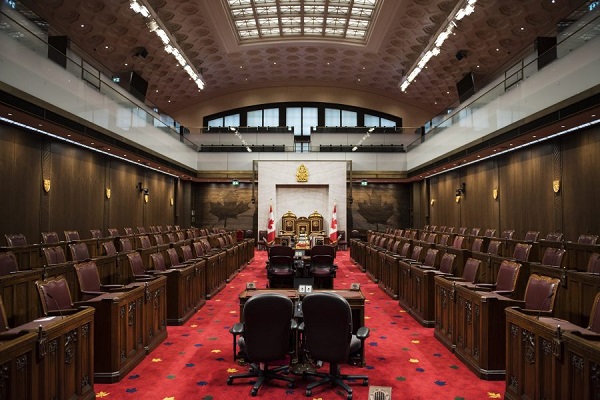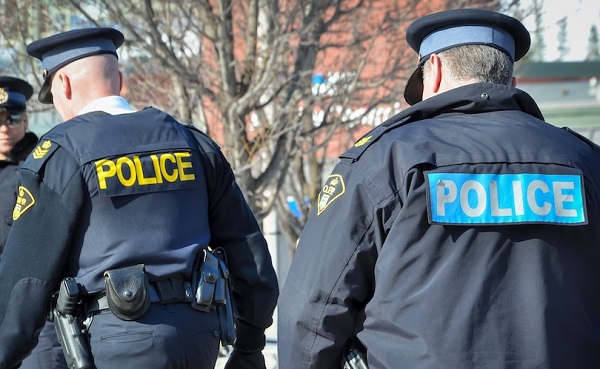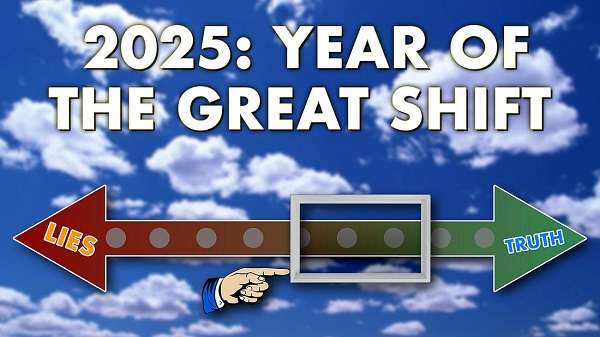Frontier Centre for Public Policy
Is the Senate in Violation of the 2006 Indian Residential Schools Settlement Agreement, and Hindering Reconciliation?

From the Frontier Centre for Public Policy
By Nina Green
Since it is abundantly clear there are no missing Indian residential school children, the ‘missing records’ by which they can be found are also imaginary, and the Senate Committee has been on a pointless wild goose chase
In July 2024 the Standing Senate Committee on Indigenous Peoples issued an Interim Report entitled ‘Missing Records, Missing Children’.
The problem with that title? There are no missing Indian residential school children.
Special Interlocutor Kimberly Murray told the Senate Committee on 21 March 2023 that there are no missing children, and in support of that one need only look to her own two interim reports, neither of which identifies a single Indian residential school child who went missing and whose parents didn’t know what happened to their child. In two years as Special Interlocutor, Kimberly Murray has not been able to name a single child who verifiably went missing from an Indian residential school.
Similarly, after two years of hearings, the Senate Committee itself was unable to name a single verifiably-missing Indian residential school child in its report.
Nor in fact has anyone in Canada to date been able to name a single verifiably-missing Indian residential school child.
Since it is abundantly clear there are no missing Indian residential school children, the ‘missing records’ by which they can be found are also imaginary, and the Senate Committee has been on a pointless wild goose chase which has cost Canadian provinces a very considerable amount of money since many of the witnesses called by the Committee have been provincial government employees whose departments have been forced to expend staff time and financial resources fruitlessly searching for records of missing Indian residential school children who are not missing.
Moreover by calling provincial coroners, medical examiners, and vital statistics department officials as witnesses, the Senate Committee has given the distinct impression that it is conducting a criminal investigation, and by focussing on Indian residential schools, the Committee has also given the distinct impression it has reconstituted itself as a new Truth and Reconciliation Commission (TRC), and is therefore in violation of the 2006 Indian Residential Schools Settlement Agreement.
What justification does the Senate Committee have for conducting this public inquiry into ‘Missing Records, Missing Children’, and threatening to compel the attendance of witnesses at its hearings?
The Committee cites the following Order of Reference passed by the full Senate as justification for its July 2024 report, and for the sweeping and far-reaching recommendations the report contains:
ORDER OF REFERENCE
Extract from the Journals of the Senate of Thursday, March 3, 2022:
The Honourable Senator Francis moved, seconded by the Honourable Senator Cordy:
That the Standing Senate Committee on Aboriginal Peoples be authorized to examine and report on the federal government’s constitutional, treaty, political and legal responsibilities to First Nations, Inuit and Métis peoples and any other subject concerning Indigenous Peoples; . . . .
It is glaringly obvious that the Order of Reference did not authorize the Committee to examine and report on missing Indian residential school children and missing records. The Senate is part of the federal government, the major party to the 2006 Indian Residential Schools Settlement Agreement under which Canadian taxpayers paid out billions of dollars to have all matters related to Indian residential schools settled once and for all – not re-opened by the Senate Committee on a whim. The Senate Committee has thus interpreted the Order of Reference as giving it an authority the full Senate did not explicitly mention, and in fact had no power to grant to the Committee.
During its proceedings over the past two years, the Senate Committee did not trouble itself to prove that there actually are missing Indian residential school children. Instead, the Committee operated on the basis that there are missing children even when Special Interlocutor Kimberly Murray told the Committee that ‘The children aren’t missing’.
Based on the false assumption that there are missing Indian residential children, the Committee proceeded to castigate those the Committee falsely claimed were ‘withholding’ records which would help to find them.
In doing so, the Committee ignored the fact that the only body which was ever actually entitled to records was the Truth and Reconciliation Commission (TRC).
Under the 2006 Indian Residential Schools Settlement Agreement, $60 million dollars was allocated to fund a Truth and Reconciliation Commission, and section 11 of the TRC’s Schedule N mandate stated that, subject to privacy interests:
Canada and the churches will provide all relevant documents in their possession or control to and for the use of the Truth and Reconciliation Commission.
It should be noted that under the TRC’s Schedule N mandate important limitations were put in place stipulating who was obligated to provide documents to the TRC, how long that obligation was to exist, and what was to be done in case of a dispute about the production of documents. The TRC’s Schedule N mandate provided that:
(1) only the federal government and the churches – i.e., not provincial governments or any other entity – were obliged to provide documents;
(2) the federal government and churches were only obliged to provide documents to the TRC during the TRC’s five-year mandate; and
(3) under section 2(l) of the TRC’s Schedule N mandate any ‘disputes over document production’ would be referred to an officially-designated body, the National Administration Committee (NAC) set up under section 4.11 of the 2006 Settlement Agreement.
The TRC concluded its work and issued a final report in 2015. That marked the end of any obligation on the part of the federal government and the churches to provide documents to the TRC, which ceased to exist and had no successor.
The Senate Committee has thus invented a problem where none existed.
That being the case – there was no problem until the Senate Committee invented one – exactly what is the problem the Senate Committee invented?
Again, one must refer back to the 2006 Settlement Agreement and the TRC’s Schedule N mandate. Section 2(a) of the Schedule N mandate states that, subject to privacy legislation, the TRC was:
authorized and required in the public interest to archive all such documents, materials, and transcripts or records of statements received, in a manner that will ensure their preservation and accessibility to the public.
To fulfil this part of its mandate, in 2013 the TRC entered into a trust deed with the University of Manitoba by which the University undertook to preserve the TRC records and make them available to the general public. That has not been done. The University of Manitoba has not made the records generated by the TRC itself in the course of its work and the records turned over to it by the federal government and the churches prior to 2015 available to the general public on its National Centre for Truth and Reconciliation (NCTR) Archives website. In particular, the University of Manitoba has not made available on its NCTR website the Sisters’ chronicles and Oblate codices which recorded daily life in the schools. Instead, the University has allowed its staff at the NCTR (which is not a legal entity and is not a successor to the TRC, but merely a building on the University of Manitoba campus staffed by University of Manitoba employees) to turn its millions of digitized records into a publicly-funded Indigenous genealogical service, as Head Archivist Raymond Frogner has explained on several occasions, and as Tanya Talaga documents in her new book, The Knowing.
Thus, if the Senate Committee had wanted to investigate an actual problem, it could have investigated why the University of Manitoba has not complied with its legal obligations under the 2013 trust deed and has not made the TRC records available to the general public as mandated by the 2006 Indian Residential Schools Settlement Agreement and the TRC’s Schedule N mandate, particularly the Sisters’ chronicles and Oblate codices which recorded daily life in the schools.
Instead of investigating that very real problem, the Senate Committee pursued a problem of its own invention by falsely claiming that records were being withheld from the ‘NCTR’ by Catholic church and provincial entities. This appears to be deliberate obfuscation because the Senate Committee must surely know that the NCTR is not a legal entity, and thus cannot legally receive documents. The actual recipient of documents sent to the ‘NCTR’ is the University of Manitoba, a fact which is never mentioned in the Senate report. Moreover the Senate report provided no evidence that any documents were actually being withheld, which of course it could not have done even had it tried since there is no legal obligation on the part of any entity to provide the University of Manitoba and the University’s NCTR staff with documents or records.
Ignoring the fact that it had invented a non-existent problem, the Senate Committee forged ahead, holding hearings and threatening to compel the attendance of witnesses. It is noteworthy that in so doing the Committee engaged in conduct which the TRC itself was forbidden to engage in under its Schedule N mandate, which states that ‘Pursuant to the Court-approved final settlement agreement and the class action judgments’, the TRC:
(b) shall not hold formal hearings, nor act as a public inquiry, nor conduct a formal legal process;
(c) shall not possess subpoena powers, and do not have powers to compel attendance or participation in any of its activities or events. Participation in all Commission events and activities is entirely voluntary;
Here is what Senator Scott Tannas had to say about holding hearings and hauling up witnesses in public on 21 March 2023 in an exchange with the University of Manitoba’s employee, Stephanie Scott:
Senator Tannas: Thank you for being here today. Ms. Scott, you mentioned that there are still organizations and people with data that has not been turned over to you. We all want to do things to help. Part of helping is listening and talking, but sometimes part of help that we can provide is to actually do something. Here in the Senate, we do have the ability to hold oversight hearings. We can compel people to come and testify before us. What would you think if you gave us the names and the contacts for organizations that aren’t providing data, and we’ll haul them up here in public and we’ll ask them why?
Ms. Scott: I would love for you to do that. We have been waiting a long time, and I think it’s absolutely crucial. When Tk’emlúps happened and the children began to speak from beyond, that’s when the world and the landscape changed for us. We used to have to do a lot of reaching out across the country, developing partnerships, still trying to acquire different records. We have worked closely — I think it’s time — the time is now, the time could be today that you call upon those people, and I would be more than willing to share that information with you. We have done a public media campaign. There are no secrets. Everything has been public and we all know what’s happened, many of us here at this table. If you are willing to do that, I respectfully would ask you to help.
Senator Tannas: I certainly would advocate for that. If you want to send the clerk, for future discussions, the name of let’s say the three most flagrant and obvious resistors, we could start maybe there and talk about it as a group. All senators would have to agree that’s a kind of meeting that we were going to have. To me, there is a time for action. As Senator Arnot mentioned, we’re not going to get anywhere until we get all the data. We won’t get to the full and complete truth, which is what all Canadians should want. It’s the only way we’re going to move forward. Thank you, that’s the only question I had.
‘Flagrant and obvious resistors’? It is unconscionable that Stephanie Scott, an employee of the University of Manitoba, would agree to provide (and did provide) the Senate Committee with a list of ‘flagrant and obvious resistors’ when she has to be aware that there is no legal obligation on the part of any entity to provide a single document to the University of Manitoba or its NCTR staff.
But even more importantly, it is unconscionable that the University of Manitoba and its NCTR employees continue to pretend that there are missing children, and continue to pretend that the University needs millions of records to identify these non-existent missing children.
Does the Senate Committee’s report further reconciliation? Obviously not. The report misleads Canadians, both Indigenous and non-Indigenous, in a way which is harmful to both by pretending that thousands of Indian residential school children are missing who are not missing, and that the provinces and the Catholic Church are withholding records that would help find them.
The Senate Committee should immediately withdraw its July 2024 interim report.
Nina Green is an independent researcher who lives in British Columbia.
Agriculture
The Climate Argument Against Livestock Doesn’t Add Up

From the Frontier Centre for Public Policy
Livestock contribute far less to emissions than activists claim, and eliminating them would weaken nutrition, resilience and food security
The war on livestock pushed by Net Zero ideologues is not environmental science; it’s a dangerous, misguided campaign that threatens global food security.
The priests of Net Zero 2050 have declared war on the cow, the pig and the chicken. From glass towers in London, Brussels and Ottawa, they argue that cutting animal protein, shrinking herds and pushing people toward lentils and lab-grown alternatives will save the climate from a steer’s burp.
This is not science. It is an urban belief that billions of people can be pushed toward a diet promoted by some policymakers who have never worked a field or heard a rooster at dawn. Eliminating or sharply reducing livestock would destabilize food systems and increase global hunger. In Canada, livestock account for about three per cent of total greenhouse gas emissions, according to Environment and Climate Change Canada.
Activists speak as if livestock suddenly appeared in the last century, belching fossil carbon into the air. In reality, the relationship between humans and the animals we raise is older than agriculture. It is part of how our species developed.
Two million years ago, early humans ate meat and marrow, mastered fire and developed larger brains. The expensive-tissue hypothesis, a theory that explains how early humans traded gut size for brain growth, is not ideology; it is basic anthropology. Animal fat and protein helped build the human brain and the societies that followed.
Domestication deepened that relationship. When humans raised cattle, sheep, pigs and chickens, we created a long partnership that shaped both species. Wolves became dogs. Aurochs, the wild ancestors of modern cattle, became domesticated animals. Junglefowl became chickens that could lay eggs reliably. These animals lived with us because it increased their chances of survival.
In return, they received protection, veterinary care and steady food during drought and winter. More than 70,000 Canadian farms raise cattle, hogs, poultry or sheep, supporting hundreds of thousands of jobs across the supply chain.
Livestock also protected people from climate extremes. When crops failed, grasslands still produced forage, and herds converted that into food. During the Little Ice Age, millions in Europe starved because grain crops collapsed. Pastoral communities, which lived from herding livestock rather than crops, survived because their herds could still graze. Removing livestock would offer little climate benefit, yet it would eliminate one of humanity’s most reliable protections against environmental shocks.
Today, a Maasai child in Kenya or northern Tanzania drinking milk from a cow grazing on dry land has a steadier food source than a vegan in a Berlin apartment relying on global shipping. Modern genetics and nutrition have pushed this relationship further. For the first time, the poorest billion people have access to complete protein and key nutrients such as iron, zinc, B12 and retinol, a form of vitamin A, that plants cannot supply without industrial processing or fortification. Canada also imports significant volumes of soy-based and other plant-protein products, making many urban vegan diets more dependent on long-distance supply chains than people assume. The war on livestock is not a war on carbon; it is a war on the most successful anti-poverty tool ever created.
And what about the animals? Remove humans tomorrow and most commercial chickens would die of exposure, merino sheep would overheat under their own wool and dairy cattle would suffer from untreated mastitis (a bacterial infection of the udder). These species are fully domesticated. Without us, they would disappear.
Net Zero 2050 is a climate target adopted by federal and provincial governments, but debates continue over whether it requires reducing livestock herds or simply improving farm practices. Net Zero advocates look at a pasture and see methane. Farmers see land producing food from nothing more than sunlight, rain and grass.
So the question is not technical. It is about how we see ourselves. Does the Net Zero vision treat humans as part of the natural world, or as a threat that must be contained by forcing diets and erasing long-standing food systems? Eliminating livestock sends the message that human presence itself is an environmental problem, not a participant in a functioning ecosystem.
The cow is not the enemy of the planet. Pasture is not a problem to fix. It is a solution our ancestors discovered long before anyone used the word “sustainable.” We abandon it at our peril and at theirs.
Dr. Joseph Fournier is a senior fellow at the Frontier Centre for Public Policy. An accomplished scientist and former energy executive, he holds graduate training in chemical physics and has written more than 100 articles on energy, environment and climate science.
Business
Ottawa Pretends To Pivot But Keeps Spending Like Trudeau

From the Frontier Centre for Public Policy
New script, same budget playbook. Nothing in the Carney budget breaks from the Trudeau years
Prime Minister Mark Carney’s first budget talks reform but delivers the same failed spending habits that defined the Trudeau years.
While speaking in the language of productivity, infrastructure and capital formation, the diction of grown-up economics, it still follows the same spending path that has driven federal budgets for years. The message sounds new, but the behaviour is unchanged.
Time will tell, to be fair, but it feels like more rhetoric, and we have seen this rhetoric lead to nothing before.
The government insists it has found a new path, one where public investment leads private growth. That sounds bold. However, it is more a rebranding than a reform. It is a shift in vocabulary, not in discipline. The government’s assumptions demand trust, not proof, and the budget offers little of the latter.
Former prime ministers Jean Chrétien and Paul Martin did not flirt with restraint; they executed it. Their budget cuts were deep, restored credibility, and revived Canada’s fiscal health when it was most needed. Ottawa shrank so the country could grow. Budget 2025 tries to invoke their spirit but not their actions. The contrast shows how far this budget falls short of real reform.
Former prime minister Stephen Harper, by contrast, treated balanced budgets as policy and principle. Even during the global financial crisis, his government used stimulus as a bridge, not a way of life. It cut taxes widely and consistently, limited public service growth and placed the long-term burden on restraint rather than rhetoric. Carney’s budget nods toward Harper’s focus on productivity and capital assets, yet it rejects the tax relief and spending controls that made his budgets coherent.
Then there is Justin Trudeau, the high tide of redistribution, vacuous identity politics and deficit-as-virtue posturing. Ottawa expanded into an ideological planner for everything, including housing, climate, childcare, inclusion portfolios and every new identity category.
The federal government’s latest budget is the first hint of retreat from that style. The identity program fireworks are dimmer, though they have not disappeared. The social policy boosterism is quieter. Perhaps fiscal gravity has begun to whisper in the prime minister’s ear.
However, one cannot confuse tone for transformation.
Spending still rises at a pace the government cannot justify. Deficits have grown. The new fiscal anchor, which measures only day-to-day spending and omits capital projects and interest costs, allows Ottawa to present a balanced budget while still adding to the deficit. The budget relies on the hopeful assumption that Ottawa’s capital spending will attract private investment on a scale economists politely describe as ambitious.
The housing file illustrates the contradiction. New funding for the construction of purpose-built rentals and a larger federal role in modular and subsidized housing builds announced in the budget is presented as a productivity measure, yet continues the Trudeau-era instinct to centralize housing policy rather than fix the levers that matter. Permitting delays, zoning rigidity, municipal approvals and labour shortages continue to slow actual construction. These barriers fall under provincial and municipal control, meaning federal spending cannot accelerate construction unless those governments change their rules. The example shows how federal spending avoids the real obstacles to growth.
Defence spending tells the same story. Budget 2025 offers incremental funding and some procurement gestures, but it avoids the core problem: Canada’s procurement system is broken. Delays stretch across decades. Projects become obsolete before contracts are signed. The system cannot buy a ship, an aircraft or an armoured vehicle without cost overruns and missed timelines. The money flows, but the forces do not get the equipment they need.
Most importantly, the structural problems remain untouched: no regulatory reform for major projects, no tax-competitiveness agenda and no strategy for shrinking a federal bureaucracy that has grown faster than the economy it governs. Ottawa presides over a low-productivity country but insists that a new accounting framework will solve what decades of overregulation and policy clutter have created. The budget avoids the hard decisions that make countries more productive.
From an Alberta vantage, the pivot is welcome but inadequate. The economy that pays for Confederation receives more rhetorical respect, yet the same regulatory thicket that blocks pipelines and mines remains intact. The government praises capital formation but still undermines the key sectors that generate it.
Budget 2025 tries to walk like Chrétien and talk like Harper while spending like Trudeau. That is not a transformation. It is a costume change. The country needed a budget that prioritized growth rooted in tangible assets and real productivity. What it got instead is a rhetorical turn without the courage to cut, streamline or reform.
Canada does not require a new budgeting vocabulary. It requires a government willing to govern in the country’s best interests.
Marco Navarro-Genie is vice-president of research at the Frontier Centre for Public Policy and co-author with Barry Cooper of Canada’s COVID: The Story of a Pandemic Moral Panic (2023).
-

 Agriculture22 hours ago
Agriculture22 hours agoWhy is Canada paying for dairy ‘losses’ during a boom?
-

 Automotive1 day ago
Automotive1 day agoFord’s EV Fiasco Fallout Hits Hard
-

 Alberta23 hours ago
Alberta23 hours agoAlberta’s new diagnostic policy appears to meet standard for Canada Health Act compliance
-

 Censorship Industrial Complex24 hours ago
Censorship Industrial Complex24 hours agoTop constitutional lawyer warns against Liberal bills that could turn Canada into ‘police state’
-

 Business2 days ago
Business2 days agoThere’s No Bias at CBC News, You Say? Well, OK…
-

 Energy2 days ago
Energy2 days agoMortgaging Canada’s energy future — the hidden costs of the Carney-Smith pipeline deal
-

 International2 days ago
International2 days agoAustralian PM booed at Bondi vigil as crowd screams “shame!”
-

 International2 days ago
International2 days ago2025: The Year The Narrative Changed






